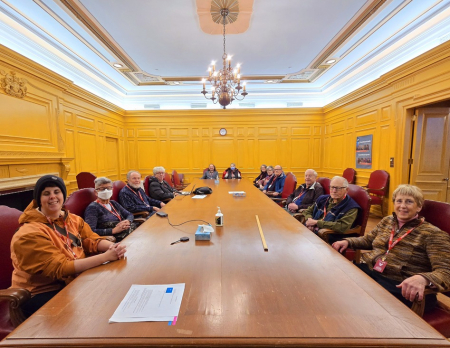Our final Museum Club outing for 2024 took place on the morning of Wednesday, November 20, and was a private tour of the National Research Council of Canada’s facility at 100 Sussex Drive. Thirteen of our members were greeted by Steven LeClair, Chief Archivist of the NRC. We were surprised to learn that apart from Library and Archives Canada, the NRC is the only federal agency that is permitted to operate an archive. All others must send their documents and artifacts to the LAC, but due to the need for rapid access to information by researchers, the NRC operates its own archive and so can respond to researchers in a day or so.
Steven gathered us in the original Council Chambers of the NRC and told us some of its early history, being founded in 1916 as the “Honorary Advisory Council for Scientific and Industrial Research”. It was a volunteer body whose membership changed along with the problems under investigation. By 1924, Henry Marshall Tory had been hired and made Chair, becoming the first President in 1928.
Steven explained that under Tory’s leadership the property occupied by the Edwards Mill on Sussex Drive was purchased and the former buildings were converted into labs. These included a wind-tunnel and a water channel. Known as the John Street Labs, the buildings proved unsuitable and a purpose-built facility was opened in 1932 at 100 Sussex Drive.
Affectionately known as the “Temple of Science” and officially known simply as building “S 77”, it is a magnificent brick and stone structure done in Neo-Classical style. Steven pointed out, as he led us on a tour of the building, the repeated use of sets of 8 Doric columns and of the Rose, Thistle, Leek, and Fleur-de-lys carvings, which were considered to represent Canada’s “founding races”, the English, Scottish, Welsh, and French. He also showed us a ceiling on which the conservation work included the use of human saliva to kill bacteria that had grown on it. The building still has many working labs which were, of course, off-limits on the tour.
We learnt from Steven, that their second President, General Andrew McNaughton, was also a civil engineer He officially held the post from 1935 to 1944, though from 1939 he had been recalled to military service and most of the day-to-day operation was led by C. J. MacKenzie, who would succeed McNaughton as President. Under McNaughton and MacKenzie the NRC was refocused to support the Allied efforts prior to and during the Second World War. The research was wide ranging and productive generating improvements in such diverse areas as powdered milk and eggs and preserving bacon to help feed the people of England, developments in explosives, anti-submarine warfare and RADAR. Following the war, it fell to MacKenzie and later E. W. R. Steacie, who held the post of President from 1952 to 1962, to transition the NRC back to its peacetime pursuits.
Throughout the tour, Steven took the opportunity to highlight some of the inventions or refinements developed at the NRC. These include the first atomic reaction in Canada, which took place at 100 Sussex Drive and later the development of the ZEEP nuclear reactor. The NRC developed Canadian Oil Light Acid, (CANOLA), originally based on rapeseed oil. NRC scientists were involved in the development of 4 track recording, the synthesizer, practical electric wheelchairs, building materials, the pacemaker, pressure molding, satellite antennas, the Canadarm and many, many other innovations. Many of these advancements were achieved through the enlightened policy of a number of the Presidents to allow their scientists to spend part of their time pursuing their own personal areas of interest and investigation.
After a brief walk-through of the original NRC library and stacks, we concluded our fantastic two hour tour in the office of Gerhard Hertzberg, which is preserved in his honour. Hertzberg, one of Canada’s most prominent scientists in the fields of Physics and Physical Chemistry, won the Nobel Prize for Chemistry in 1971. He served with the NRC from 1948 until his death in 1999 at age 94.
Addendum from Steven Leclair
Here is the link to the NRC Digital Repository for the NRC Archive’s photos, the AVRO Arrow collection, and a few others: NRC Digital Repository - Canada.ca
FYI – for non-water marked photos people can request directly to me using the title or item identifier. There are no costs and everything posted is available to download.
This email address is being protected from spambots. You need JavaScript enabled to view it.
Some of my historical posts: Under the microscope: The John Street Labs






